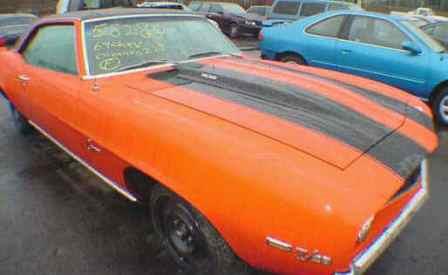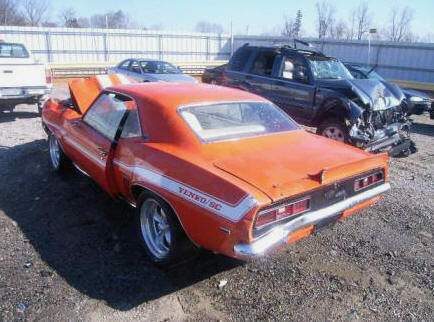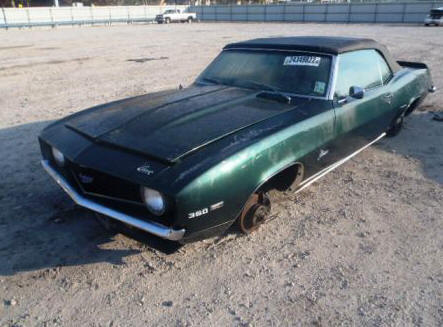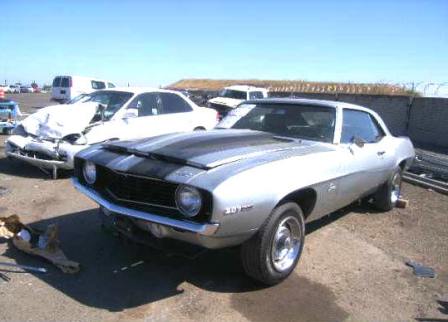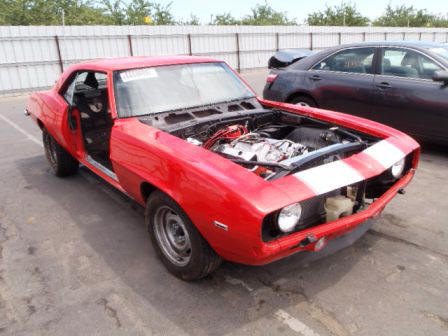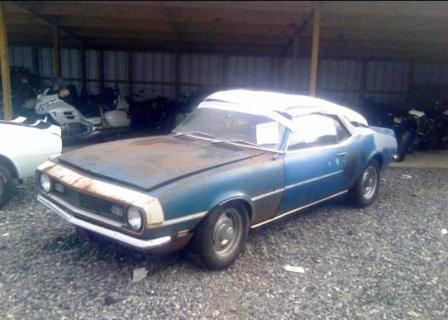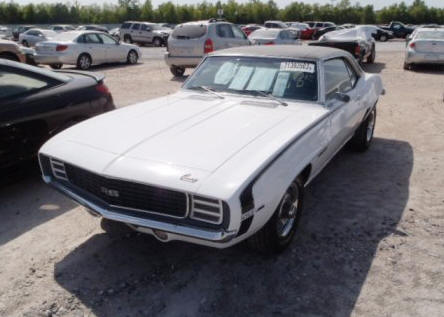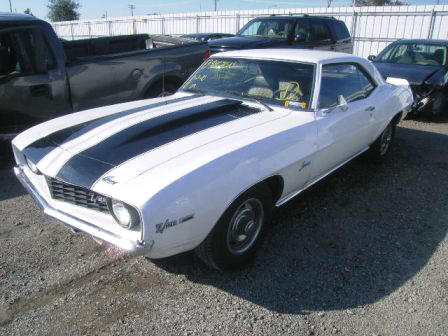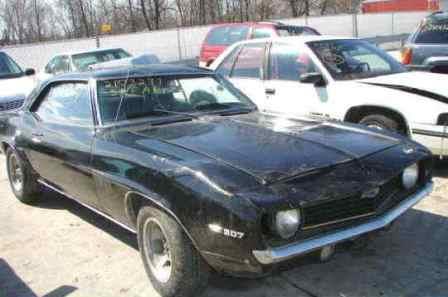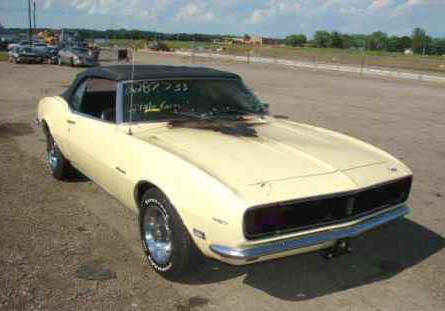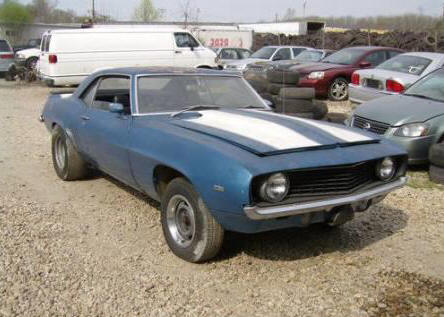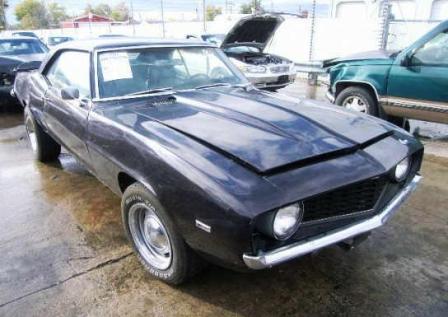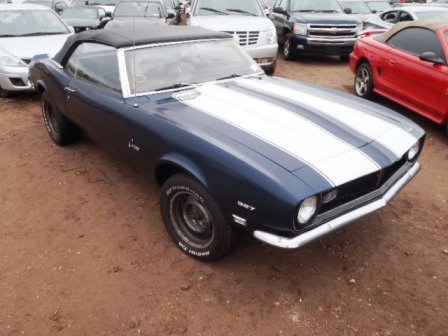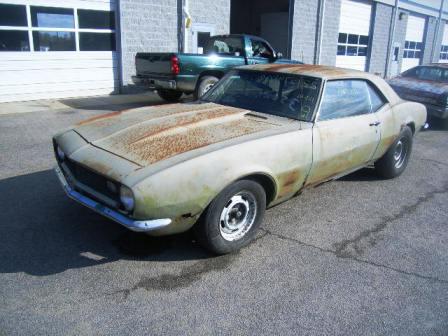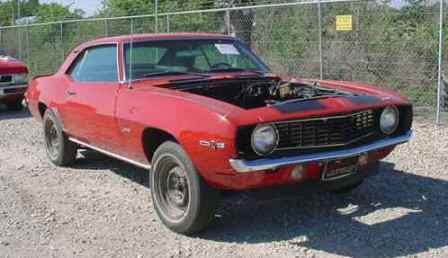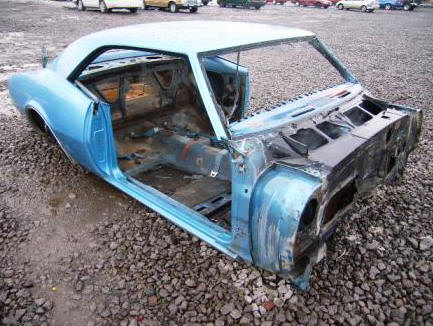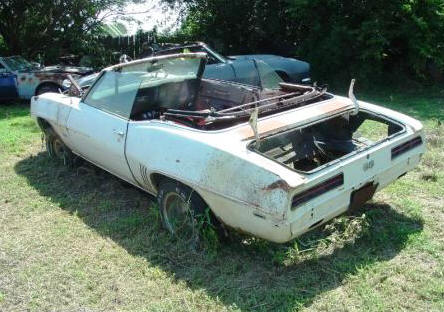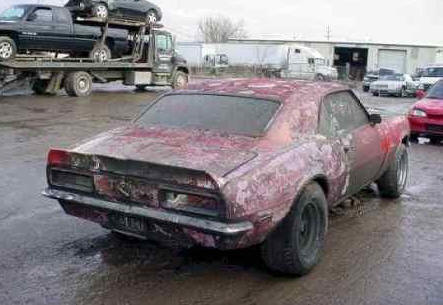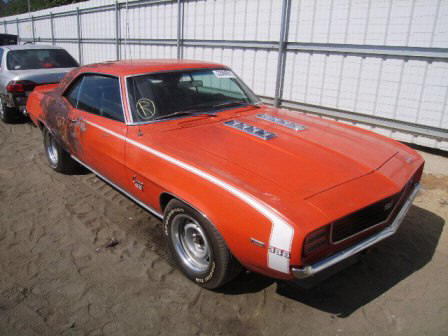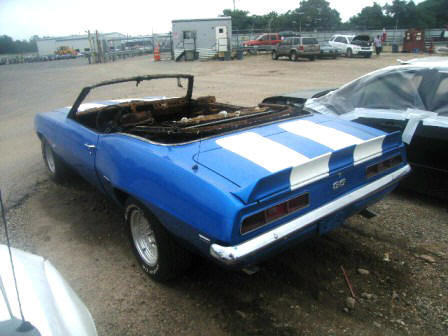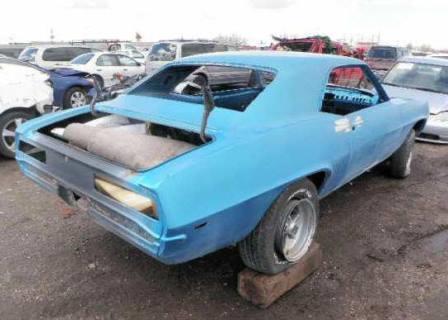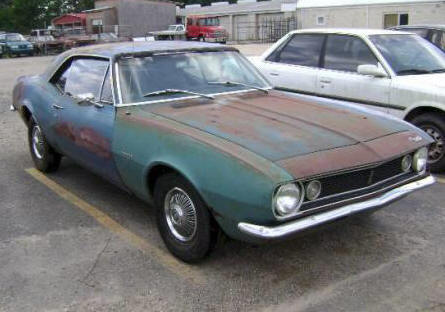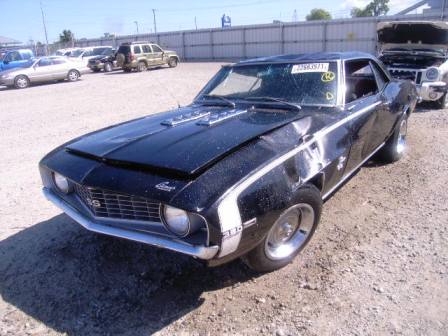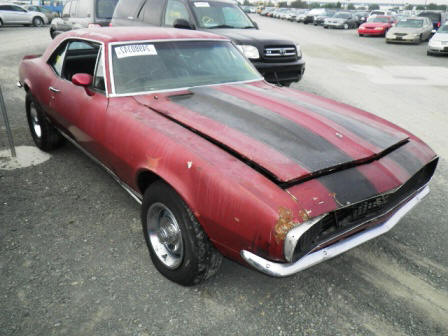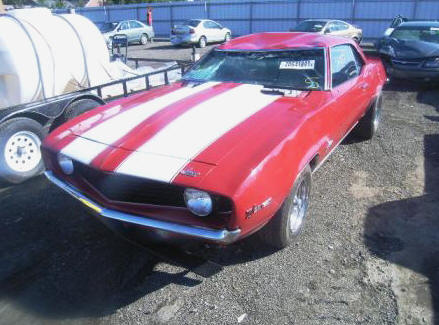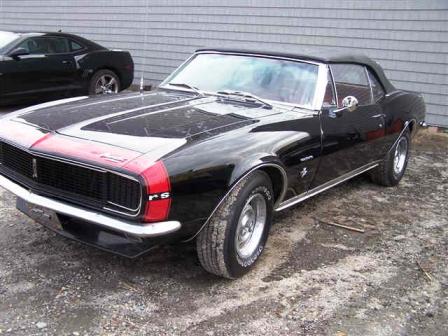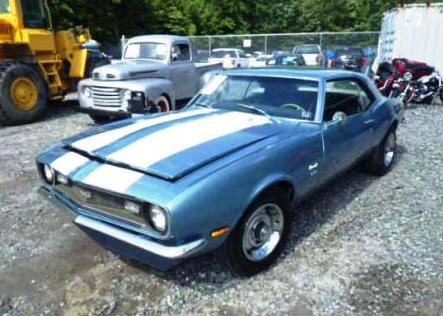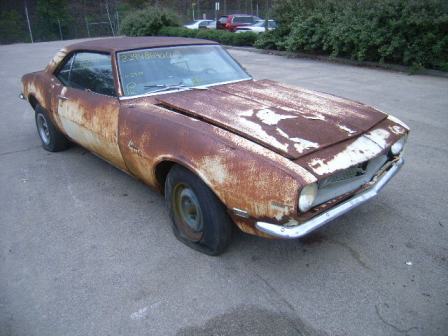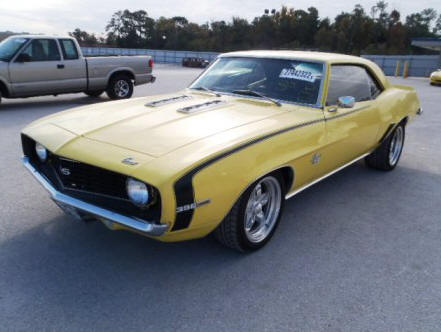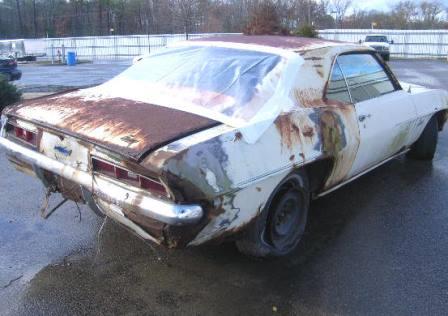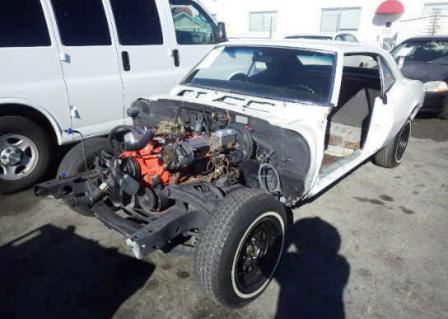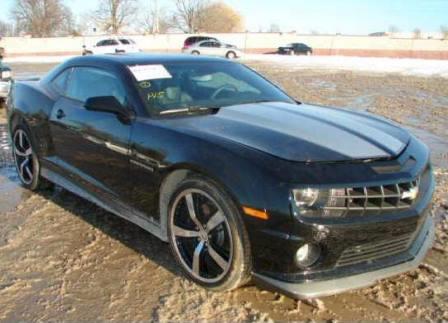|
CAMARO PROJECT CARS FOR SALE 1967 1968 1969
1969 Camaro Z28 - Theft Recovery - $4,900 - #23 CA-909 We specialize in repairable salvage cars. Go to our website to see more than 11,0000 salvage cars, motorcycles, trucks, jet skis, boats, atvs, rvs, semi trucks, trailers, forklifts, tractors, snowmobiles, industrial equipment and project cars for sale at substantially discounted prices. These are just a few examples of the project cars for sale each week. Vehicles can be inspected and picked up in-person or purchased online and delivered to your door. National and international delivery is available with Customs Brokerage services for prompt worldwide transport. CLICK HERE to view entire inventory of Camaro and muscle project cars for sale and view a large inventory of more than 11,000 late model, easy repairable salvage motorcycles, cars, boats, airplanes, trucks, trailers and industrial vehicles currently for sale. The inventory changes daily.
* Our business was established in 1976 and is backed with a 100% Money-Back Guarantee.
1969 Camaro YENKO/SC 427 - Collision Damage - MAKE OFFER - #74 HG-773
1969 Camaro Convertible - Flood Damage - $7,100 - #44 JN-39
1969 Camaro - Theft Recovery - $6,400 - #14 MG-463
1969 Camaro - Stolen and Stripped - MAKE OFFER - #99 TF-912
1968 Camaro Convertible - Project Car - $5,900 - #81 KJ-143
1969 Camaro RS - Theft Recovery - MAKE OFFER - #53 TX-901
1969 Camaro Z28 - Theft Recovery - MAKE OFFER - #23 PY-671
1969 Camaro - Flood Car - $3,000 - #45 AZ-193
1968 Camaro Convertible - Carburetor Fire - $3,300 - #85 IL-383
1969 Camaro - Flood Car - $4,600 - #25 TX-356
1969 Camaro - Theft Recovery / Stripped - $4,900 - #93 GA-896
1967 Camaro 327 Convertible - Storm Damage - $6,100 - #23 FL-336
1968 Camaro - Project Car - $4,100 - #63 JX-016
1969 Z28 Camaro - Theft / Stripped - $3,900 - #30 TX-656
1967 Camaro SS - Stolen and Stripped - $2,800 - #48 FL-901
1969 Camaro Z11 Convertible Pace Car - MAKE OFFER - #78 FL-561
1968 Camaro - Interior Fire - $1,600 - #55 AZ-993
1969 Camaro SS396 - Flood Damage - $5,300 - #34 FN-129
1969 Camaro SS Convertible - Interior Fire - $6,200 - #81-KA 432
1969 Camaro - Stolen and Stripped - $3,000 - #10 CA-919
1967 Camaro - Project Car - MAKE OFFER - #99 NV-432
1969 Camaro - Rollover Damage - $3,100 - #19 CT-752
1967 SS Camaro - Project Car -
$4,300 -
#39 NY-542
1969 Camaro Z28 - Rollover Roof Damage - $6,600 - #34 HN-39
1967 Camaro RS Convertible - Flood Damage - MAKE OFFER - #18 MA-861
1968 Camaro SS - Theft Recovery - MAKE OFFER - #98 FL-441
1968 Camaro SS - Project Car - $3,100 - #28 UL-475
1969 Camaro SS396 - Theft Recovery - MAKE OFFER - #61 AZ-365
1969 Camaro - Project Car - $2,900 - #91 TX-225
1967 Camaro - Stolen & Stripped - MAKE OFFER - #89 CA-768
2013 Camaro SS427 - Flood Car -
$12,300
- #24 TX-441 Choose from a large variety of salvage cars for sale - here's just a few examples. We are salvage car specialist and these are only a few examples of the project cars for sale each week. Visit our website to view an inventory of more than 11,000 classic project cars and easy repairable late model salvage cars currently for sale - inventory changes daily. Vehicles can be purchased online and delivered to your door or you can make on-site inspections and haul them away yourself. National and international delivery is available with full service Customs Brokerage for worldwide delivery to any location at very competitive rates. CLICK HERE to see entire inventory of muscle cars and Camaro project cars for sale and view an inventory of at least 11,000 late model, repairable salvage cars, motorcycles, trucks, boats, atvs, rvs, semi trucks, trailers, forklifts, tractors, jet skis, snowmobiles, industrial equipment for sale. *
Our company began in 1976 and we are backed with a 100% Money-Back Guarantee. All inventory listings are subject to prior sale. |
HISTORY OF THE CHEVROLET CAMARO
First Generation Camaro 1967 - 1968 - 1969
Just as the first
Mustang was based on Ford's compact Falcon, so the first 1967 Camaro was based
on Chevy's compact Nova. However, it was based on the upcoming redesigned '68
Nova and therefore more robust than a comparable '67 Nova.
The basic
engineering of the Camaro was a unibody structure from the windshield and
firewall back, with a separate steel rail subframe for everything up front.
Double A-arms made up the independent front suspension while the solid rear axle
was suspended by semi-elliptical leaf springs. As was typical of
standard-equipped vehicles at the time, braking was by four drums, the steering
was slow and manual, and Chevy's rugged 230-cubic-inch straight six poked out an
optimistically rated 140 horsepower while twisting a three-speed manual
transmission.
The base $2,466 '67 Camaro sport coupe was lean and
aggressive, as was the convertible. Adding substance to that appearance was done
either by picking or combining individual options or trim packages called RS and
SS. Buyers could opt for a larger 250-inch version of the six making 155
horsepower, a 210-horsepower 327-cubic-inch small-block V8 fed by a two-barrel
carb, that same V8 with a four-barrel carb and a higher compression ratio was
rated at 275 horsepower, or two versions of the 396-cubic-inch big-block V8
making either 325 or 375 horsepower. Those engines could be lashed to a series
of wide- or short-ratio three- or four-speed manual transmissions, or one of two
automatics: the slushy two-speed Powerglide or outstanding three-speed
Turbobydramatic.
The Rally Sport (RS) appearance package brought deluxe
interior trim and hidden headlights with it, and the high-performance Super
Sport (SS) package had its own distinct decoration (including a domed hood with
simulated vents, "bumble bee" stripes encircling the nose and the iconic SS
badges), a heavy-duty suspension and larger D70-series tires on 14-inch wheels.
Beyond that, the SS-350 model also offered a new 350-cubic-inch small-block V8
rated at 295 horsepower — Chevy's first 350. The Rally Sport and Super Sport
packages could also be ordered together to form the most lavishly equipped
Camaro of them all, the RS/SS. And it was an RS/SS convertible powered by a 396
that Chevy provided as pace car for the 1967 Indianapolis 500.
Almost
outside the regular Camaro line was the race-oriented Z/28. Introduced in
December 1966, the Z/28 was powered by a special high-compression 302-cubic-inch
V8 whose displacement was achieved by matching the short-stroke crank of the
283-cubic-inch version with the big-bore block of the 327. Rated at 290
horsepower and built to rev, the radical power plant was matched to a more
aggressive suspension. How did the first Camaro perform? Car Life magazine's
test of an SS-350 had it completing the quarter-mile in 15.8 seconds at 89 mph
while Motor Trend reported that its SS-350 did the same trick in 15.4 seconds at
90 mph. Thanks to "Astro Ventilation," General Motors eliminated the side vent
wing windows on the 1968 Camaro and also added federally mandated side marker
lights and a revised base grille). Mechanically, the most significant change was
the adoption of staggered rear shocks (one in front of the rear axle, one
behind) to counteract wheel hop under hard acceleration.
While the 1969
Camaro's structure and mechanical elements were virtually unchanged from the '68
model, new fenders, door skins, rear quarter-panels, grille and taillights gave
the car a wider, lower appearance. A redesigned dash and more comfortable seats
made it more livable, too. But it was the staggering array of available
performance equipment that marks 1969 as the greatest model year for Camaros. On
the yawn side, a new low-performance 200-horsepower 307-cubic-inch small-block
(a 327 crank in a 283 block) supplemented the low-performance 327 and a new
255-horsepower 350 replaced the better-performing 327. On the yeow side, Chevy
produced its second Camaro Indianapolis 500 pace car and offered replicas of the
white RS/SS convertible with orange stripes and orange houndstooth upholstery to
the public (the actual pace car was powered by a 396, but most of the replicas
had 350s). In addition, two radical Camaros were produced in extremely limited
numbers under special Central Office Production Orders (COPO) 9560 and 9561.
The COPO 9561 was a basic Camaro sport coupe stuffed with 427 cubic inches
of all-iron big-block making 425 horsepower. Most of the 1,015 COPO 9561s were
delivered to Pennsylvania's Yenko Chevrolet for conversion into that
dealership's signature Camaro. Even rarer was the COPO 9560 featuring the
legendary all-aluminum ZL-1 427 also rated at 425 horsepower. Only 69 of the
ZL-1s were built, and because of their rarity, tremendous output and relatively
low weight, they are today considered the quickest and most valuable Camaros
ever built. Sales of the 1969 models extended into the winter of 1969 and early
1970; some of these lingering '69s may have been titled as 1970 models, leading
to some confusion.
Second Generation Camaro (1970½ - 1981)
Though
it didn't make it to market until February of 1970, the second-generation 1970½
Camaro would be in production 12 years. The second-generation Camaro's styling
was inspired by Ferrari and was also bigger, heavier and no longer available as
a convertible. And as the 1970s progressed, it would grow less powerful,
succumbing to the pressures of tightening emissions regulations and a fuel
crisis. Still based on the Nova, the new Camaro was engineered much like its
predecessor in that it still used a unibody structure with a front subframe,
leaf springs in the back and A-arms up front for suspension. Those A-arms were
freshly designed and the steering gear moved from the back to the front of the
front axle, but otherwise the basic mechanical pieces were familiar.
Also
familiar were most of the engines. The 155-horsepower 250-cubic-inch six was now
the Camaro's base engine, followed by the who-cares 200-horsepower 307, the
lowliest of V8 offerings. A 250-horsepower two-barrel 350 effectively replaced
the 327. Order the SS package and the 350 earned a four-barrel carb and
additional compression to reach 300 horsepower. Moreover, SS buyers could pay
even more and get a 350- or 375-horsepower 396 big-block V8. As before, the
Camaro was offered with Rally Sport or Super Sport equipment or both. The Rally
Sport package featured a unique front-end appearance with a split front bumper
and a center grille cavity encircled in rubber. The SS again had heavier-duty
suspension and the "SS" logos.
The star 1970½ Camaro was again the Z/28,
now powered by a 360-horsepower high-compression "LT-1" 350. Unlike the
high-revving 302 used in the first Z/28s, the LT-1 was easy-going in everyday
traffic, still revved with enthusiasm and was now available with an automatic
transmission. Car and Driver's test had the '70½ Z/28 ripping to 60 mph in 5.8
seconds and running through the quarter-mile in 14.2 seconds at a full 100.3
mph, though the drivers still found it lacking in bottom-end power. But the
glory days of the LT-1 would last just that one year. With emissions regulations
growing tougher, GM dropped compression ratios across the board for 1971 and
also adopted "net" alongside "gross" power ratings for its engines (by '72, all
engines were only net rated). For the 250-cubic inch inline six, the power
rating dropped from 155-gross to 110-net horsepower. For the LT-1, the drop was
a 30-horsepower plunge down to a 330 horsepower gross and 275 horsepower net.
Otherwise, the '71 barely changed from the '70½ model; high-back bucket seats
were new, and the rear spoiler on Z/28s was now a larger three-piece unit.
The 1972 Camaro changed mostly in the engine bay where the horsepower
devastation continued. The LT-1 could now only poke out 255 horsepower (net) and
the most robust big-block (still called a 396, but in reality a 402) was making
just 240 net horsepower.
In 1973 the bumpers were slightly revised and
the horsepower drain continued with the base six now making an utterly lame 100
net horsepower and the L82 only 245. The big-block was off the option sheet
altogether. In place of the Super Sport was the "Type-LT" Camaro, which bundled
a slew of luxury options into one cohesive package. To meet new bumper
regulations, the 1974 Camaro was redesigned with thick aluminum bumpers front
and rear. The one-and-only grille (the Rally Sport option vanished) was now
shovel-shaped and the rear taillights wrapped into the fenders. But there were
no changes to the available engines and trim levels.
With unbelievable
shortsightedness, Chevy killed the Z/28 and pared the engine selection down to
just three catalyst-equipped lumps for 1975 — the 250-cubic-inch six now rated
at 105 horsepower, a two-barrel 350 V8 making a pathetic 145 horsepower and a
four-barrel version of the same engine rated at a meager 155 horsepower.
Distinguishing the '75 from '74 was a new rear window that wrapped down into the
roof sail panels. Also new for '75 was a "Rally Sport" package that consisted of
two-tone paint and some tape stripes.
For no apparent reason, the '75
Camaro sold well, so there were few changes to the 1976 model. An aluminum panel
between the taillights was now used on the Type-LT, power brakes were finally
standard and cruise control was a new option. The two-barrel 350 was killed in
favor of an even-crummier two-barrel 305 producing 140 horsepower while the
four-barrel 350 now whacked out a still-inexcusable 165 horsepower. When the
1977 Camaro appeared, there were again few changes (intermittent wipers
anyone?), but in the middle of the year, the Z/28 returned as a separate model
whose concentration was now on handling and appearance. And the new Z/28 did
handle well, even if it only had 170 horsepower aboard from the same 350
four-barrel V8 offered in other Camaros (up 5 horsepower from '76). The '77
Camaro was thoroughly lackluster, but with Ford foisting the hideous Mustang II
upon America, for the first time, more Camaros (198,755) were sold than Mustangs
(161,654). Daring to mess (however lightly) with success, Chevrolet equipped the
1978 Camaro with a new nose that put the big bumpers under soft plastic. Five
models were now offered (sport coupe, Rally Sport, Type-LT, Type-LT Rally Sport
and Z/28), and translucent T-tops were a new option. The Z/28's full-disco body
package (with front fender vents and a fake hood scoop) was supported in '78
with a revised version of the 350 V8 now rated at a better-but-still-weak 185
horsepower.
Though almost a carryover from '78, the 1979 Camaro would
prove the most popular one yet. The Type-LT vanished in favor of a new trim
level called Berlinetta, but the engines were all unchanged, even though power
ratings were rattled a bit in contending with emissions requirements (Z/28
output dropped to 175 horsepower for 49-state cars). The most substantial change
to the '79 Camaro was a new instrument panel with more contemporary
instrumentation and better control placement. Chevy sold a stunning 282,571
Camaros during the 1979 model year — a number it would never top. Looking to
improve fuel economy, Chevy mangled the Camaro's engine lineup for 1980 while
leaving the rest of the car pretty much alone. A new 115-horsepower
229-cubic-inch V6 (basically a small-block V8 with a pair of cylinders hacked
off) — or, in California, a 110-horsepower 231-cubic-inch V6 replaced the
ancient inline six, and a new 267-cubic-inch two-barrel version of the
small-block V8 debuted, rated at a laughable 120 horsepower. On the positive
side, output of the Z/28's 350 grew to 190 horsepower, except in California
where buyers got a 155-horsepower 305-cubic-inch V8 mated to a mandatory
three-speed automatic. Caught in a fuel crisis, Camaro sales nose-dived to
152,005 during the 1980 model year.
The antiquated platform of the
second-generation Camaro had run its course by the 1981 model year. With a new
engine control computer aboard, all engines were now certified for all 50
states, but output on the Z/28's 350 dropped to 175 horsepower. The Rally Sport
died (again) and the '81 Camaro lineup consisted of three well-defined models:
base sport coupe, Berlinetta and Z/28. Those three model names would survive to
see 1982, but not much else.
Third Generation Camaro (1982 - 1992)
Third-generation Camaros were the first built without front subframes or
leaf-spring rear suspensions. Now the front end was held up with a modified
MacPherson strut system, and the hind end relied on a long torque arm and coil
springs. These were also the first Camaros with factory fuel injection,
four-speed automatic transmissions, five-speed manual transmissions,
four-cylinder engines, 16-inch wheels and hatchback bodies. In January 1982, the
Camaro was, for the first time since 1967, truly all-new and slightly smaller.
But the 1982 engine selection was hardly scintillating. Base sport coupes
started with a 90-horsepower version of GM's lethargic 2.5-liter "Iron Duke"
four and could be optioned up to a 112-horse 2.8-liter V6 (base engine in the
Berlinetta) or a four-barrel carbureted 5.0-liter (305-cubic-inch) small-block
V8 rated at 145 horsepower. That V8 was the Z28's base powerplant; buyers could
opt for a Z28 "Cross-Fire Injection" (throttle body-injected) version producing
165 horsepower. The carbureted V8 could be had with either a three-speed
automatic or four-speed manual, but the injected engine was automatic only.
A Camaro paced the Indianapolis 500 again in 1982, and the silver and blue
replicas of that car are probably the most attractive of the '82s. However, the
T-top Z28 that actually paced the Memorial Day classic that year used a highly
modified 350 (5.7-liter) V8 for motivation that wasn't available to the general
public. Kind of sad, really. The three-tier Camaro lineup continued into 1983
with minimal visual differences. However the Z28 got a nice power bump with the
introduction of the "L69" engine option. With a Corvette-spec camshaft, revised
exhaust and a healthy four-barrel carb, the 5.0-liter L69 "H.O." V8 was rated at
190 horsepower and could be backed by a new five-speed manual transmission.
For 1984, availability of the L69 improved on Z28s (the junky Cross-Fire engine
died) and the four-speed "700R4" automatic was adopted by most Camaro models.
Because anything digital was, of course, good, the Berlinetta sprouted a
funkadelic digital instrument panel and overhead console this year, as well. The
instrumentation was probably more entertaining than the V6 that powered most
Berlinettas. The great leap forward in third-generation Camaro performance came
with the introduction of the 1985 IROC-Z, named after the International Race of
Champions, which was contested with Camaros. The IROC featured big 16-inch
five-spoke wheels and unique graphics. Carbureted versions of the 5.0-liter
small-block V8 were still available, but the big improvement came with the
fitment of Tuned Port Injection (TPI) to that engine to produce a flexible 215
horsepower. Sadly, the TPI engine could only be had with the four-speed
automatic (in either the IROC or the regular Z28).
Beneath the Z28, the
sport coupe and Berlinetta blustered through 1985 unchanged, except for a new
fuel-injected version of the 2.8-liter V6 that now pushed out 135 horsepower.
The 1986 Camaros were easy to spot because of the goofy blister fitted atop
their rear hatches to accommodate the federally mandated center high-mounted
stop light (CHMSL). Beyond that, there was a new exhaust system for non-Z28 cars
and a new basecoat/clearcoat two-stage paint system. Big engines returned to the
Camaro for 1987 with the good old 350 (5.7-liter) V8 making its way into IROC-Zs
as an option. Capped with the TPI system, the 5.7 was rated at a full 225
horsepower — the highest horsepower in a Camaro in 13 years and with vastly
better drivability. While the TPI 5.7 came only with the four-speed automatic,
the TPI 5.0 liter was finally available with the five-speed manual.
Equally good news was the comeback of the Camaro convertible — the first Camaro
convertible since 1969 — and the consignment of the four-cylinder engine to a
well-deserved eternity in the junkyard. The high-output carbureted 5.0-liter V8
also disappeared, and a new 165 horsepower carbureted 5.0-liter V8 became the
standard Z28 engine. Also gone from the '87 Camaro line were the Berlinetta
(replaced with an "LT" option package), and, on any Camaro with a rear spoiler,
that ugly CHMSL housing on the rear glass. The CHMSL was instead built into the
spoiler and Chevy would simplify its own production for 1988 by making the rear
spoiler standard on all Camaros. So that brake light blister was gone entirely
from the 1988 Camaro, but so was the Z28. Since Chevy had firmly established the
IROC name, all high-performance '88 Camaros became IROCs. Base '88 Camaros,
meanwhile, inherited the elegant 15-inch five-spoke wheels from the Z28, as well
as the Z28's lower body skirting. Also, the Z28's 5.0-liter V8 was now optional
on the sport coupe; it gained a throttle body fuel-injection system to make 170
horsepower. The rarest and most intriguing '88 Camaro was the 1LE road racing
package optional on the IROCs with both the 5.0- and 5.7-liter TPI engines.
Featuring oversize disc brakes, an aluminum driveshaft and a well-tweaked
suspension, the 1LE was built to win showroom stock road races.
Proving
that no name is forever dead in the world of Camaros, the old "RS" (but not
Rally Sport) designation returned for the 1989 model year. Looking much like an
'85 Z28, the RS was a basically a trim package atop the base sport coupe and was
powered by either the V6 or a throttle-body-injected 5.0-liter V8. Although the
5.7 TPI V8 now boasted 240 horsepower, about the only way to tell '89 IROCs from
previous years is to look at the ignition key and see if has the "Pass-Key"
theft deterrent resistor embedded in it. The IROC breathed its last breath
during the short 1990 model year, as Dodge picked up sponsorship of the
International Race of Champions. The big changes that year were the growth of
the base V6 from 2.8 to 3.1 liters, with a bump in output from 135 to 140
horsepower and the fitment of driver-side airbags to all models.
Chevy
jump-started the 1991 model year by re-introducing the Z28 in the spring of
1990. Sure, the '91 Z28 got a tall rear wing, new lower body cladding, new phony
hood scoops and new five-spoke wheels, but it was otherwise still an IROC and
now the top engine was a 245 horsepower 5.7-liter TPI V8. All other '91 Camaros
were pretty much '90 Camaros with revised ground effects that featured fake air
inlets. Law enforcement got its own Camaro in 1991 with the introduction of the
Camaro B4C pursuit vehicle. Basically, a B4C was a Z28 that was badged as an RS
and equipped with most of the good stuff developed for the 1LE race package.
Very few B4Cs were ever produced. With an all-new Camaro coming for 1993, the
1992 model was barely changed from '91. The big change was that they all sported
a "25th Anniversary" badge on their instrument panels. Further, a $175 "Heritage
Package" of stripes was offered for any '92 Camaro. It was time for another new
Camaro.
Fourth Generation Camaro (1993 - 2002)
While the 1993
fourth-generation Camaro was very much new, it was shy of all-new; much of the
floor stamping and all of the rear suspension was shared with the
third-generation car. But with plastic front fenders, a new short-arm/long-arm
front suspension, rack-and-pinion steering and a sleek new profile, the '93 was
new enough. For '93, the Camaro lineup was pared to two models: base sport coupe
powered by a 160-horsepower 3.4-liter version of GM's V6 and the Z28 with the
Corvette's 5.7-liter LT1 small-block V8 underrated at 275 horsepower. Once
again, the convertible was gone. The black-roofed (no matter what the body
color) '93 Z28 was a stunner. The LT1 was easily the most powerful small-block
installed in the Camaro since its namesake, the 1970 LT-1, and, considering the
move from gross to net power ratings, probably even more powerful than that
legend. Behind it was either a four-speed automatic or six-speed manual
transmission and 16-inch wheels and tires; and four-wheel antilock disc brakes
were standard. With Z28 prices starting under $17,000, the value was just
amazing. The most desirable '93? Probably the black Z28 replicas of that year's
Indy 500 pace car. These replicas were identical to the actual pace car which,
in stark contrast to the '82, led the race with no mechanical changes.
As
expected, the convertible Camaro returned with the 1994 model year. Designed and
built by GM at the St. Therese, Quebec, plant where all F-cars were assembled,
the '94 ragtop's chassis was significantly stiffer than the previous
convertible's. Otherwise it's almost impossible to tell a '94 coupe from a '93
unless one opens up the automatic transmission and finds that it is the
electronically controlled version of the 4L60.
While the 1995 Z28
received only minor changes (all-season tires and traction control were now
available), the base Camaro added GM's "3800" 200-horsepower 3.8-liter V6 as an
option. The 3800 was both significantly more powerful and refined than the 3400,
and by 1996 would become the only V6 in Camaros. With the adoption of the 3800
as standard power, the least powerful 1996 Camaro still had more power than the
most powerful 1984 Camaro. Somewhat in celebration, the RS name reappeared on
the V6 coupe as a spoiler and ground effects package. Meanwhile on the Z28 side,
the V8's output jumped to 285 horsepower and SLP Engineering brought back the SS
name by adding engine tweaks and 17-inch five-spoke wheels wrapped with
P245/40ZR17 BF Goodrich Comp T/A tires. The SS, with its 305 horsepower rating
was the first factory Camaro to break the 300 horsepower barrier since 1971, and
the first of any year using net ratings.
To celebrate the Camaro's 30th
anniversary, Chevy introduced a specially optioned white Z28 with orange stripes
and orange houndstooth upholstery (evocative of the '69 Camaro pace car) for
1997. Otherwise, there were new "tri-color" tail lamps for all models, and SLP
produced an extremely limited run (106 cars) of 330-horsepower Corvette LT4
5.7-liter V8-powered Camaro Z28 SS models.
The fourth-generation Camaro's
first (and only) extensive visual update came for 1998 with a new front fascia
design. But the real news lay behind that face where the C5 Corvette's new-age
all-aluminum small-block LS-1 V8 took up residence in the Z28. The 5.7-liter
LS-1 was the first all-aluminum engine offered in a Camaro since the '69 ZL-1
and carried a thrilling 305-horsepower rating (base Camaros kept the
200-horsepower 3800 V6). GM took over production of the SS itself this year, as
well, with the ram-air induction system boosting the LS-1 to 320 horsepower.
Except for electronic throttle control on V6 models, a new oil life monitor and
a Torsen limited-slip differential, the 1999 Camaros were indistinguishable from
the '98 models. In turn, the 2000 Camaros were pretty much the same as the '99s,
except for radio controls integrated into the steering wheel, body-color side
view mirrors, some new interior fabrics and an optional 12-disc CD changer.
By 2001, it was obvious that the Camaro's days were numbered, and the only
changes to the car were restyled 16-inch wheels, a new paint color and the
unchanged LS-1's output rating to 310 horsepower in the Z28. Grimly, the Camaro
soldiered on into 2002. For the Camaro's last year in production, changes were,
understandably, minimal. Z28s got a new power steering cooler, the sound systems
were revised and V6 convertibles got the automatic transmission standard, but
that's about it. Chevrolet did celebrate the car's 35th year, however, with a
special graphics package for the Z28 SS coupe and convertible. The flamboyant
stripes and logos of the 35th Anniversary package were attractive in their own
idiomatic way, but it was hardly the glorious send-off for which Camaro
enthusiasts had hoped.
Fifth Generation Camaro (2010 - Present)
After eight years of flying the Chevy flag at half-mast, Camaro enthusiasts had
their prayers answered when Chevrolet brought back its road burner for 2010.
Initially available only as a coupe in base LS, midlevel LT and V8-powered SS
models, this is without a doubt the best Camaro to date. The retro styling
borrows shamelessly from the 1969 Camaro, down to the cowl-induction-style hood,
Coke bottle profile, cross-hatch grille and rear-quarter gills. Yet it's not a
complete knock-off, as the 2010 has a huskier stance and is noticeably thicker
in the rear haunches. The cockpit is mostly modern, with a few old-school
touches thrown in such as a quartet of gauges located down low in front of the
gear shifter. The latter isn't exactly an ergonomic success, but they pay homage
to the optional setup of the late '60s. The available RS package (essentially an
appearance package) adds bigger (20-inch) wheels, a rear spoiler, HID headlights
and smoked taillights.
Unlike before, getting a V6 Camaro doesn't mean
"plenty of show but not so much go." The LS and LT come packing 304 hp via a
direct-injected, 3.6-liter V6. It also has a six-speed manual transmission
(six-speed automatic optional), disc brakes all around, an independent rear
suspension (a Camaro first) and 18-inch wheels. At a base price of around
$23,000, the entry-level Camaro offers a heavy dose of performance that's light
on the wallet. With 0-to-60 and quarter-mile times of 6.0 and 14.2 seconds,
respectively, these are seriously rapid cars. The big-dog SS has a 6.2-liter V8
with either 426 hp (with six-speed manual) or 400 hp (with six-speed automatic)
as well as meatier Brembo disc brakes. With the ability to leap to 60 mph in 5
seconds and tear down the quarter-mile in 13 seconds flat, the SS will show its
tail lights to virtually any Camaro that came before, perhaps even the super rare
ZL-1 of 1969. And in terms of unraveling a twisty road, the latest Camaro has no
peer with its elders, thanks to a finely balanced and tuned chassis, the
aforementioned independent rear end and quick, communicative steering.
CLICK HERE to see the entire selection of 1969 Camaro and muscle project cars for sale
.
